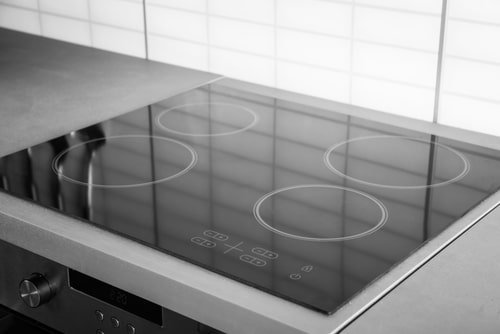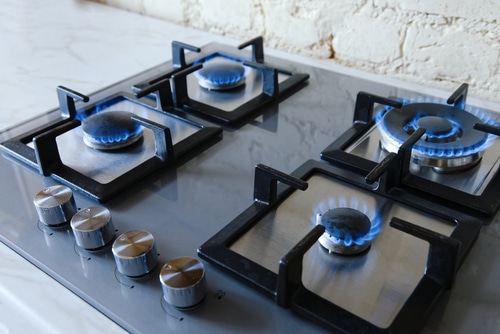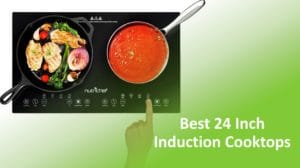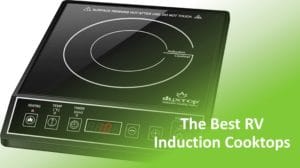When it comes to an induction cooktop vs gas, personal preference plays a large role. Both stovetop arrangements cook beautifully and provide much faster heating than a conventional electric stove.
First, I’ll break down how each cooktop functions, then I’ll give you the induction vs gas cooking pros and cons. After you’re done reading, you’ll have a solid idea of which cooktop is best for you.
Induction Cooktop

Induction stoves have been around for nearly 100 years. They were first introduced at the 1933 World’s Fair in Chicago, debuting as a near-future technology. Luckily for us, we’re living in that future!
Induction stovetops work by sending electrical impulses through a copper coil located below the stovetop’s surface. The electric impulses create an effect on the cooking instrument of choice, which heats up due to magnetic induction.
Magnetic induction is the process where heating occurs within the cooking vessel due to the electric impulses that pass through the pot or pan. Instead of warming the pan from the outside, which is the case with both conventional electric and gas stovetops, induction stoves heat cooking instruments from within with electrical impulses.
Heating only happens within the pan, while the stovetop stays much cooler, only heated by the warmth generated in the cooking vessel. That means you lose much less thermal energy than with other stovetops.
The main thing to keep in mind about induction stoves is the need for magnetic cooking vessels. If you have an aluminum or copper pan, it won’t heat up on an induction stove because it does not interact with magnetic fields. Some copper or aluminum pots have a layer of steel or cast iron so you can use them on induction stoves.
Gas Cooktop

Gas cooktops have been around since the early 1820s and have used numerous types of gas in that time span. The most common gas we use today in gas stoves is natural gas, which is mostly made of methane.
Gas cooktops have been the choice of professional kitchens for the last 50 years. Most chefs prefer gas cooktops because they heat up faster than conventional electric stoves and they can use any sort of cookware without worrying about conductivity. Chefs also claim cleaning gas cooktops is easier than other stovetops.
Gas stovetops work by hooking up to a municipal or private gas network. Gas stoves usually have one of the two most common ignition methods. The first is an electric ignition, which creates a spark when you turn on the gas.
The other method for gas ignition is a pilot light. A pilot light is a small flame that’s always present on your stove. When you turn the gas on, the pilot light ignites whichever burner you’re using.
Gas heats up cookware from the outside, so sometimes the heat distribution is not equal on all parts of the pan. Although you can use any metal cooking vessel on a gas stove, the best are made from multiple layers of metal. By having multiple layers, the pan will retain heat better, resulting in more uniform cooking.
Induction vs Gas Cooking Pros and Cons
Now that we know how each stovetop functions, let’s break down what makes them good, and what areas they could improve on.
Induction Cooktop Pros
Induction cooktops are notable because of their safety, speed, and precise temperature controls. Let’s break down each of these advantages and show you why they create a better cooking environment.
Safety
Induction cooktops use electromagnetic impulses to create heat in your pan. The electric impulses don’t create heat, but rather transmit thermal energy into the pan itself. That means the pan itself will heat up, but the cooking surface will remain much cooler.
Without a flame or element heating up, you and anyone else in the kitchen will remain much safer. There’s no chance of accidental burns occurring from touching the cooking surface, nor is there any chance of fires that result from a kitchen towel or other fabric item touching the cooking surface.
Speed
Induction cooktops don’t lose any thermal energy to the surrounding air like gas or conventional electric stovetops. Instead, the pan heats up directly, which means it becomes hot much faster than other cooking methods.
When it comes to cooking, speed doesn’t just save you time, but it saves on electricity too. Since heat isn’t lost during cooking, you’ll use much less energy than other cooking methods, which lose heat to the surrounding air.
Precise Temperature Controls
Have you ever used a stove, turned it on to medium-low and realized that it’s much hotter than you expected? It’s a common problem when you use a stove you’re unfamiliar with. Luckily, induction stoves don’t have that problem.
Since induction stoves transfer their heat directly into the pan, you can control how much you heat the pan precisely. Once you lower the heat, you’ll see an immediate difference in how much heat is entering the pan. The inverse is also true, so if you apply more heat, be ready for a hotter cooking surface.
Induction Cooktop Cons
Now that we’ve seen the advantages of induction cooktops, let’s look at some of its downsides.
Requires Specific Cookware
Induction stoves only work because of the electromagnetic impulses sent from the copper coil in the cooktop to your pan. If your pan isn’t magnetic, it won’t heat up on an induction stovetop. Here are some cookware materials that will not work in on an induction stovetop:
- Glass
- Aluminum
- Copper
Learning Curve
If you’ve never used an induction stove before, it can take some getting used to. Induction heats up pans much faster than any other cooktop, so you may burn your food the first few times you try out your new cooktop.
You also have to place the cookware in the right spot. If your pan is off-center or not in proper contact with the cooking surface, the coil will not send electrical impulses. It can be frustrating finding the ins and outs of an induction stove when you first start using it.
Gas Cooktop Pros
Gas cooktops have the advantages of price, versatility, and durability over induction stovetops. Let’s break down each of these advantages and explain why they can benefit you in the kitchen.
Cheaper
Since gas stoves have been popular for so long, their manufacturers perfected their supply chains. That means, on average, a gas stove is much cheaper than the average induction stove.
Natural gas is also cheaper in most states than electricity, which means you’ll save on your bills each month if you have a gas stove.
Versatile
Gas cooktops are versatile in a couple of ways. First, you can use any type of cookware on a gas stovetop. Whether that’s copper, aluminum, or a cast iron pan, gas burners aren’t limited to a few cookware materials like induction stoves.
Gas stoves are also versatile because they don’t need electricity to operate. If your power goes out, you still have the ability to cook, whereas an induction oven would need to wait for the city to restore power.
Durable
One of the reasons professional kitchens prefer gas over any other stovetop is its durability. Gas stoves have strong metal grates that your pan rests upon while heating over the flame. These metal grates are usually removable for easy cleaning, too.
The metal grates protect the gas burner from any damage. Conventional electric and induction stoves are prone to damage, like cracks or scratches. With a gas cooktop, you won’t have to worry about those problems.
Gas Cooktop Cons
Now that you know the advantages of a gas cooktop, let’s look at some of the disadvantages that you may experience with a gas stove.
Potential Hazards
Gas stoves present two major hazards that you need to be aware of. The first is the potential for gas leaks. Gas leaks can fill your house with flammable gas, so it’s essential to be on guard for any indication a leak occurred. Luckily, natural gas smells like rotten eggs, so you should have some warning that a leak occurred.
The other hazard you need to be aware of is the potential for carbon monoxide (CO) to build up in your home. If too much CO builds up in your home, it can cause CO poisoning, which can be fatal. Always have a CO monitor in your home if you plan on installing a gas cooktop.
Professional Installation
Gas stoves require professional installation. Both conventional electric and induction stoves hook up to an electrical outlet. Gas stoves need to hook up to the gas lines in your home, which can be dangerous. Never install a gas stove yourself. Having a professional do it for you will be quicker and safer.
Related Article: Best Portable Induction Cooktop
So, Induction or Gas?
When it comes to gas vs induction cooktops, the best choice depends on how you’ll use your stove. If you’re looking for the fastest cooking times and most accurate temperatures, an induction stove is for you.
If you’re looking for a cheaper option, both in initial and running costs, a gas cooktop is for you. At the end of the day, induction vs gas stoves is up to your personal preferences.







Cooking :Could you report on the carbon (CO2) production of induction vs. standard Electric burners, and Natural Gas burners? Thank you.
Thanks for your suggestion, Jim. We’ll put this into our content team’s idea list to consider for a future article.